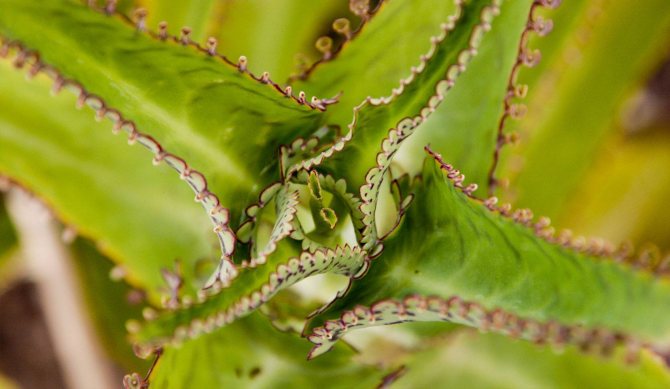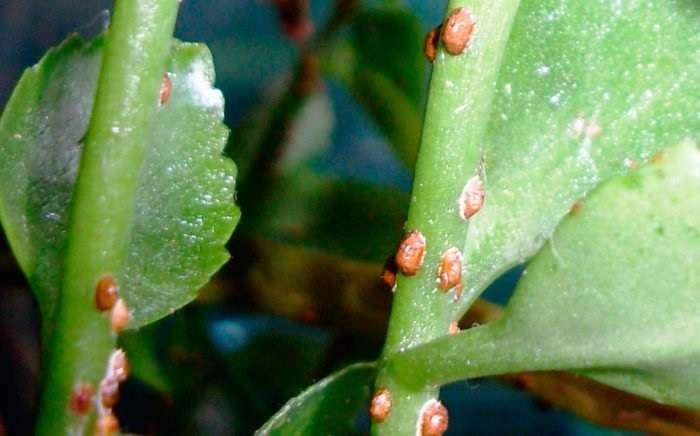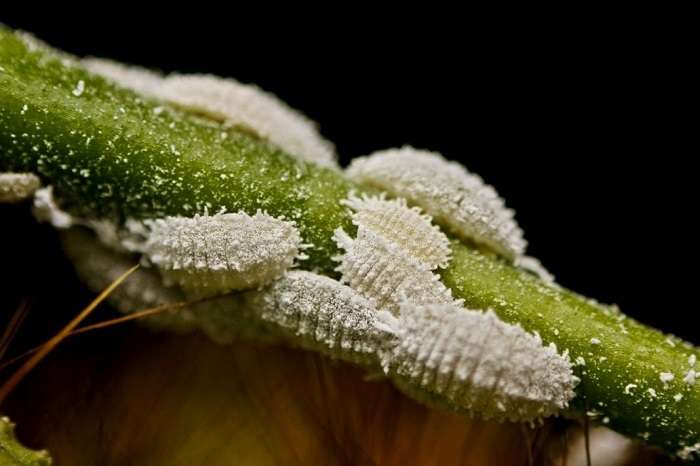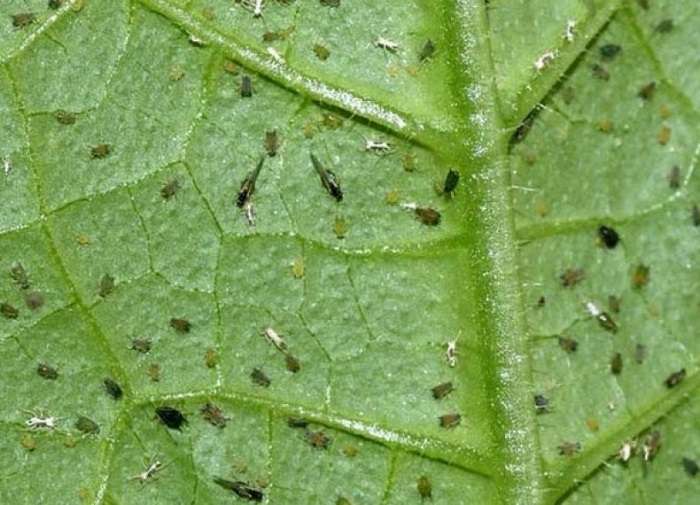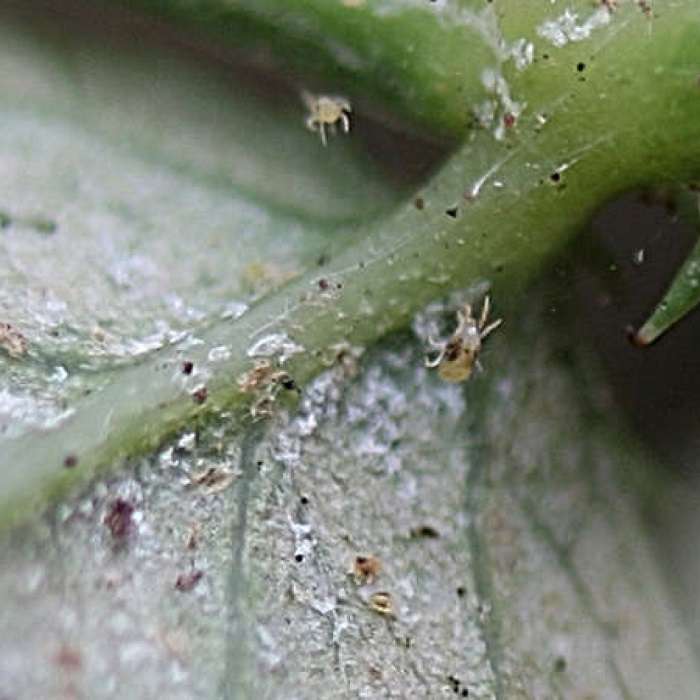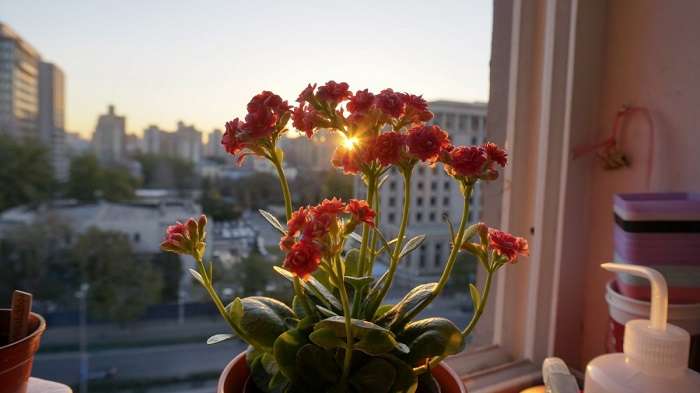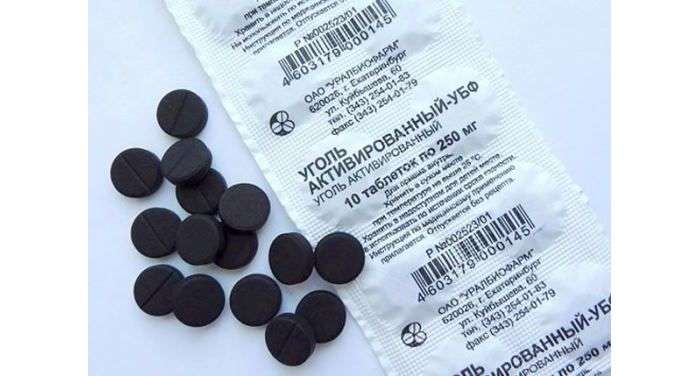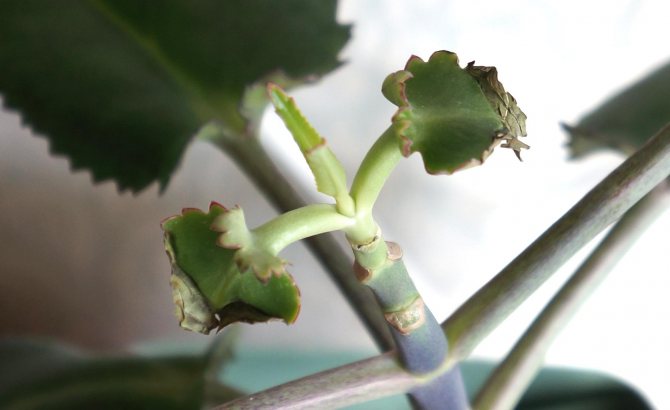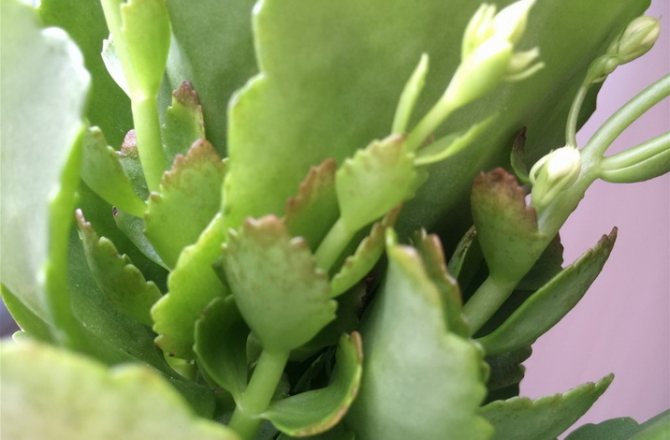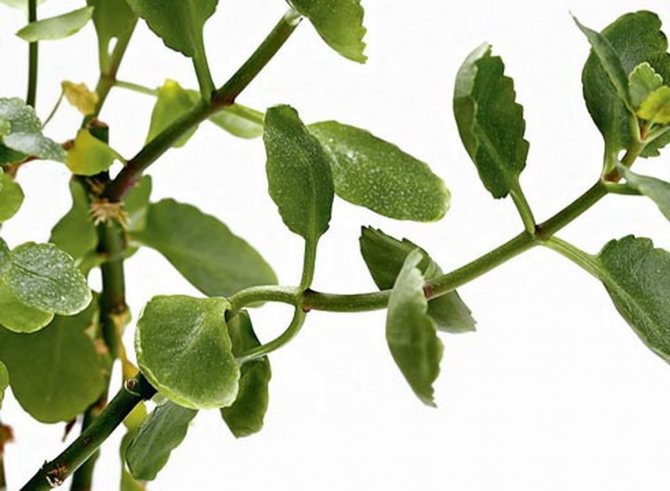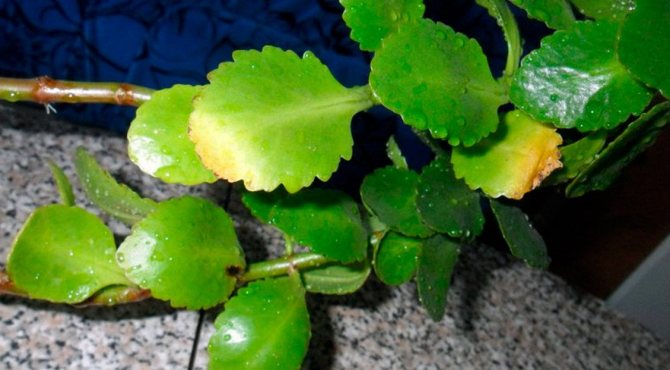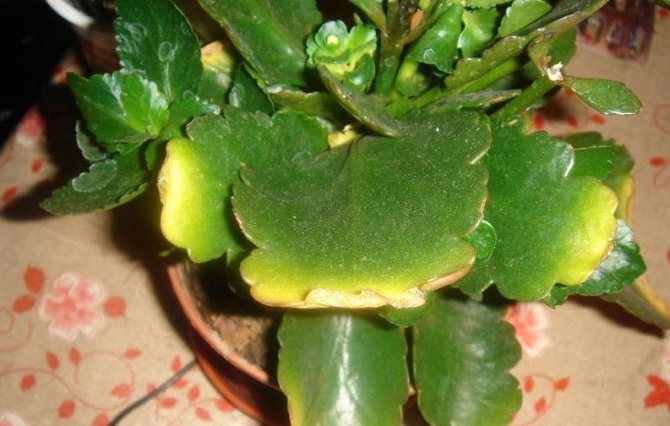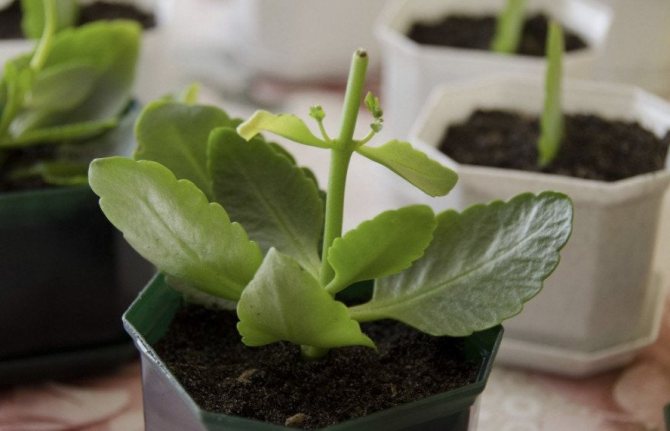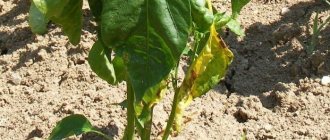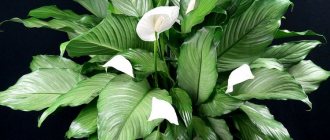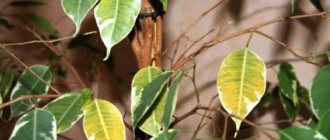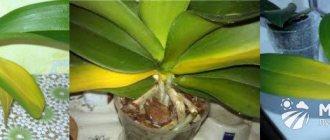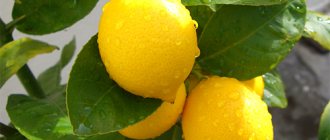Posted in Succulents, Care Published 01/04/2019 · Comments: · Read: 10 min · Views: 1 457
Although Kalanchoe is inferior in popularity to another common succulent - aloe, it is still often found on home windowsills, and some of its varieties are highly valued in folk medicine.
It is not difficult to grow this plant, and even beginner growers can cope with this task. But, sometimes the owners are faced with the fact that Kalanchoe leaves turn yellow, as well as other unpleasant symptoms appear. What are the reasons for such negative changes, how dangerous are they and how can a succulent be saved?
Leaflet diseases: causes and treatment
The first signs of the appearance of diseases can be observed by changing the shape of the leaves or the base of the flower. By their deformation, it is possible to determine the degree of damage in order to think over an effective treatment regimen.
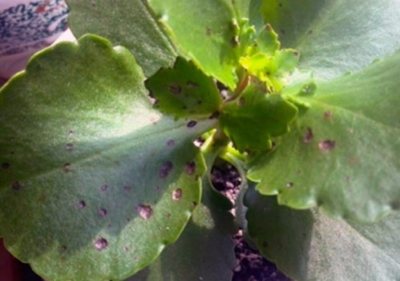
- Late blight rot characterized by the appearance of brown spots on the leaves. Gradually, a brown plaque begins to form. It is necessary to change the scheme of watering, airing and process the Kalanchoe leaves until stains and plaque are removed.
- White spots with bloom signal the next disease known as powdery mildew. An indoor plant “complains” about a too dry climate. Perhaps the plant was poorly watered. Therefore, it is necessary to observe the plant more carefully in order to choose the most optimal watering frequency.
- With gray rot leaves become very sticky. Special preparations cannot always help, since a complete replacement of the land cover may be required.
- Stem rot captures the stems of plants after it freezes.
For the Kalanchoe, peculiar types of pests are also characteristic:
- Mealy worms become not only pests, but also carriers of a fungal infection - black mold.
- From the parasitic beetle known as the scale insect, the leaves and shoots of the Kalanchoe simply begin to dry out. The scale insect does not like excessive moisture, therefore, sometimes an ordinary sprayer can become an effective way to eliminate the parasitic creature.
- In the room, ticks may appear, which are already sitting on the base of the Kalanchoe stem. When watering a flower, sometimes you should look at the inside of the leaves and the very shoot of the plant.
Succulent diseases
Kalanchoe are quite unpretentious and can tolerate various changes without any problems. And besides, they have strong immunity and rarely get sick, but, nevertheless, sometimes it happens. Most often, diseases arise due to improper care - too frequent and abundant watering, prolonged droughts and other negative factors.
Late blight lesion
With late blight, Kalanchoe leaves are covered with brown or grayish-brown spots and a bloom consisting of fungal spores. In the affected plant, the shoots become soft, flabby and die off.
The main causes of the disease are waterlogging of the soil, poor ventilation and low air temperature. The treatment of a succulent consists in correcting mistakes - it should be placed in a warm room with dry air and the number of watering should be reduced. And also requires treatment of the flower with antifungal drugs.
Powdery mildew
The fungus infects flowers that lack moisture amid high air temperatures. In this disease, the foliage of the plant becomes covered with a whitish bloom, reminiscent of mold. Later it turns brown, black dots appear, the leaves dry, curl and fall off. The same happens with the buds and flowers of the Kalanchoe, if it is blooming.
Without treatment, the succulent dies quickly. And in order to save the pet, you should normalize its habitat and apply a fungicidal preparation.
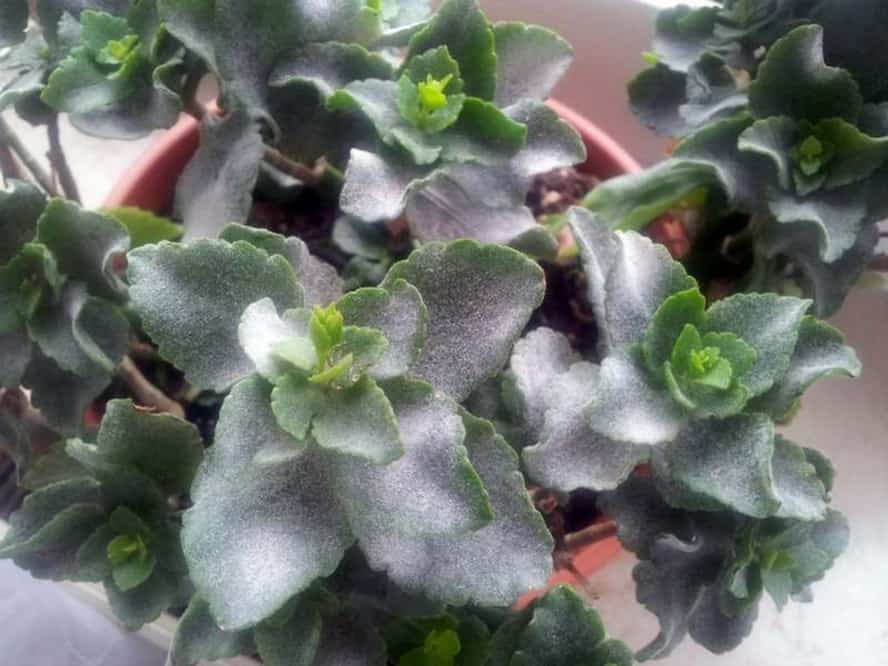

Gray rot
With this disease, the flower becomes covered with wet putrefactive spots with a grayish bloom. The main reasons are dampness, poor lighting, stagnant air. Gray rot is treated in the same way as late blight.
In the case of any diseases and pests, it is important for the florist to catch the slightest changes in the state of the green ward and respond in a timely manner. In the early stages, curing a succulent is much easier.
Yellowing
The first symptoms of improper Kalanchoe care appear on the leaves. They just turn yellow.
Leaves can not only change color. The disease in the process of its active development can cause their deformation. Then they fall off. After the leaves have disappeared, most likely, the plant is already at the last stage before its final death.
Diagnostics
During the next spill, you may notice that the leaves of the plant droop a little. Small bugs may appear on the stems of the plant or under the leaves, which are a demonstration that the Kalanchoe is in a really deplorable state.
The reasons
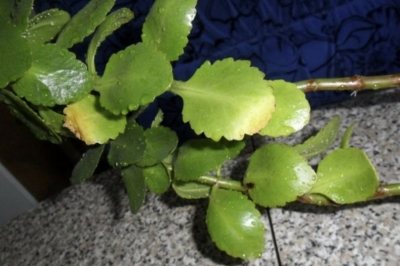

The main reason for the yellowing of the leaves is the wrong approach to watering the plant. If you pour it, it can lead to flooding of the roots, which will constantly be in a humid environment. Then you will need to give the plant a break from the period of regular flooding.
It is recommended to water the Kalanchoe about once a week. After watering, after about 15 minutes, you should go up and check if there is water left in the pan. If so, just drain the stand and return it back under the flowerpot. When Kalanchoe leaves fall - this is his way to declare too active watering. Excessively dry soil also negatively affects the growth of Kalanchoe. If you change the watering mode too often, it will also lead to a change in the color or shape of the leaves.
Yellowing of the leaves can be an indicator of the lack of the required amount of minerals. With a deficiency of zinc in the soil, the flower loses the desired tone and the process of change towards death begins.
However, in the modern world, in a flower and plant store, specialized outlets, you can find the necessary fertilizers for Kalanchoe.
Instructions: what to do if leaf plates turn yellow and dry?
- After determining the type and cause of the disease, you can proceed to effective methods of treatment.
- Soap solution is considered one of the home treatments for the plant. It is also recommended to use alcohol or garlic tinctures to wipe leaves on which pests could start.
- Consult with specialists and purchase specially developed medicines that eliminate the causes of the disease as soon as possible.
- Use fertilizers to bring the missing minerals back into the Kalanchoe soil.
- Pinching the flower can speed up the healing process.
From the video you will learn about why Kalanchoe leaves dry and fall and how to treat the plant:
Why Kalanchoe turned yellow: 5 main reasons
This flower is considered the most problem-free among pets. It grows well in a wide temperature range, withstands drought and winter lack of lighting. Its leaves serve as a kind of indicator of health - in response to stressful conditions, they begin to turn yellow, dry out and eventually fall off.
The main reasons for the yellowing of Kalanchoe:
- violation of lighting;
- improper watering, low humidity;
- errors in temperature conditions;
- depletion of the soil, improper feeding;
- other problems: stress, lack of pruning, pests.
The problem of yellowing of leaves applies equally to flowering and non-flowering species; young and adult plants are not spared. To recognize and eliminate the cause, carefully examine the flower and assess the situation in the growing area.
Succulent leaves can turn yellow all over the plant at once or in some areas - it depends on various factors. Let's consider these situations in detail.
Preventive measures
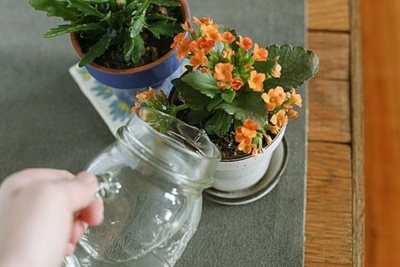

As a preventive measure, you can rearrange the houseplant in the well-lit side of the living space. Also, do not forget to ventilate the room from time to time, because sometimes poor ventilation of the room can cause the formation of spots of different colors and shades, signaling the appearance of one of the types of rot.
Fertilization should be done not only during the intensive care period, but also at other times of the year.
Soil depletion, improper feeding
In the absence of a transplant, the root system grows, it becomes cramped in the old pot. In addition, a gradual depletion of the soil occurs, as a result of which the Kalanchoe begins to experience a deficiency of nutrients. In this case, the growth of the flower is suspended, the leaves become smaller and turn yellow.
Note! Regular fertilizing is not an alternative to transplanting.
Young bushes are transplanted annually, the soil in pots of adult plants is changed every 2 years. If the Kalanchoe is still actively growing, the planting capacity is chosen 1.5-2 cm wider and deeper than the previous one.
It is advisable to take a commercial soil mixture intended for succulents, since it has a balanced composition. The drainage layer is made of any suitable material (pebbles, expanded clay, brick chips) with a layer of at least 1 / 5-1 / 4 of the depth of the pot.
Succulents are sensitive not only to a lack, but also to an excess of nutrients, so they feed them very carefully. Mainly flowering species are fertilized from late spring to early autumn. Top dressing is carried out no more than 2 times a month with compositions for succulent plants. The concentration of the solution is made 2 times weaker than that recommended in the instructions.
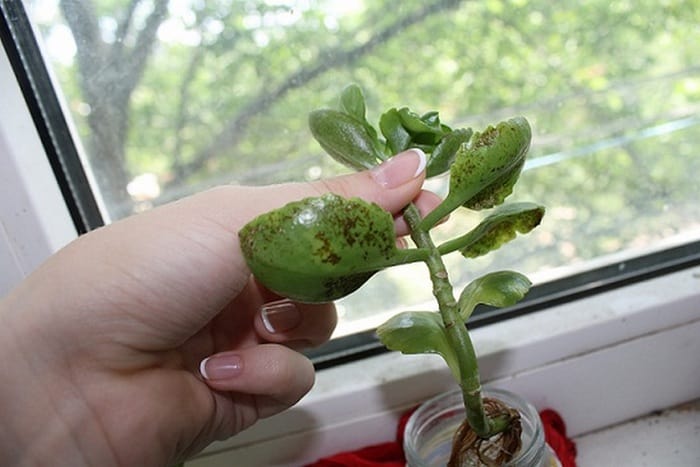

Correct care
- Kalanchoe quickly absorbs water and for a long period can store moisture inside the soil, therefore, the plant should not be flooded with water.
- In the summer, a sunny place in an apartment or house should be arranged for the Kalanchoe, while in the winter the plant can be in its darker corners. It is it that blooms in the cold period.
- The optimum temperature for growth in winter is 15 degrees Celsius, while in summer it can withstand hotter climates - up to 28 degrees Celsius.
- It should be replanted as needed during the period of active revitalization of nature - in the spring. To do this, you will need to choose a larger flowerpot, change the drainage and fertilize the soil.
- From time to time, you can spray to blow away dust particles.
Kalanchoe is a guest in our area, but in a short time the plant was able to get used to a new climate and environment. It has become a favorite of many apartments and houses not only because of its medicinal quality. In winter, it pleases its owners with amazing flowering.
If you find an error, please select a piece of text and press Ctrl + Enter.
Lighting violation
Kalanchoe belongs to light-loving cultures, since in the natural environment of the tropics it settles on rocky slopes, in light forests, river floodplains. Therefore, the flower loves bright, but diffused lighting and long daylight hours - at least 10-12 hours.
Note! If only the upper part of the foliage turns yellow, and the lower part remains green, then this is a sure sign of a lack of lighting..
If the leaves turn yellow or turn brown throughout the bush, you can suspect that it has been under the hot sun for too long. Symptoms of localized sunburn caused by water droplets on leaf plates are brown spots.
The way out of the situation is to find a new place for the green pet. After proper organization of lighting, Kalanchoe quickly restores its decorative effect.
The best option would be a window sill on the east or west side, where the direct rays of the sun hit only in the evening or morning. If there is a lack of natural light in winter, move the pot to the south window, if this is not possible, arrange artificial lighting.
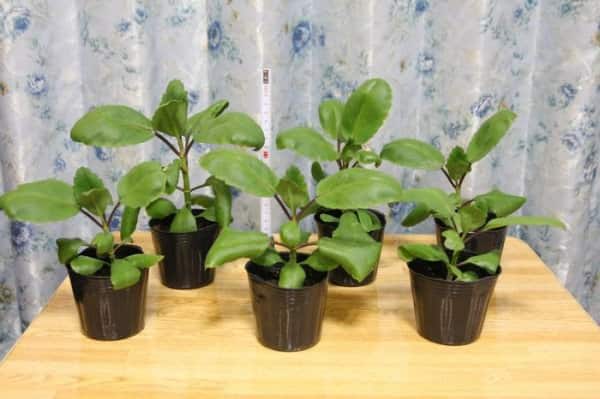

Possible pests and diseases of the plant and how to deal with them
Insects and diseases can provoke the shedding of Kalanchoe foliage. Let's consider methods of their elimination.
Aphids on Kalanchoe
Aphids are an insidious pest that intensifies activity in the spring season. It is a carrier of more than 100 types of pathogenic microbes. A flower infected with aphids turns yellow, then loses its foliage. With a severe form of infection, the death of the plant is not excluded.
Did you know? The inclusion of Kalanchoe in the list of medicinal plants was preceded by a case. In the 60s of the XX century, a letter from a small village came to Kiev Medical University, where a resident shared that he received an unusual plant as a gift that could heal wounds. After this letter, the study of the medicinal properties of the Kalanchoe began.
Initially, you may not even suspect the presence of an insect, because it settles on the back of the leaf plate. But already settled colonies of small green or black individuals can be easily seen on young shoots and inflorescences. The presence of aphids is also evidenced by the sticky mass covering the foliage and stems. Parasites love Kalanchoe juice, they inject a toxin into the plant, thereby poisoning it.
If urgent measures are not taken, the pest can spread to nearby crops. To remove aphids, first remove all affected parts, and treat healthy parts once a week with an insecticide such as Aktara, Iskra, Commander or Confidor. After a month, the problem should be resolved.
The plant can be cured with such a folk remedy as green potassium soap. To do this, dilute 20 g of soap in 1 liter of water. Wrap the soil in a plastic bag, and rinse the aerial part of the plant with soapy water.
Shield and false shield
The scale insect is a harmful insect with an elongated miniature body covered with a protective wax shell. Females are larger than males and lack legs and wings.
The false shield is distinguished from the real one by the absence of wax shields. Eggs and larvae are protected by the dying female's drying skin.
The larvae of the pest spread throughout the plant in just a few hours after hatching. Located on the underside of the leaf plate, the parasite sucks the juices out of it. Adult scale insects and false scale insects are usually motionless, while young ones like to move. Visually, the colonies of this insect look like plaques on the Kalanchoe.
The first step is to clean off parasites. Use a toothbrush for this. It is also recommended to wash the plant with soapy water, then carry out treatment with an insecticide such as "Oksikhom", "Tsineb", "Tiram".
From unconventional means, wiping with a cloth soaked in diluted alcohol will help (repeat the procedure 3-4 times a week). Garlic infusion is also effective, the basis of which is 5 cloves of a vegetable and 200 ml of water. The composition should stand in a dark place for 2 hours, after which it must be filtered. The green part is sprayed with such a liquid until the scabbard is completely eliminated.
Also read why Kalanchoe leaves turn yellow.
Other pests and diseases
In addition to the above, the flower can be bothered by such harmful insects as multi-claw mites and mealybugs. The former cover the surface of the leaves with a brown scab. Small glassy specimens can be washed off with soapy water. Then treat the flower with an insecticide (Aktara, Aktofit, Akarin, Fitoverm, Mospilan, Fufanon).
Similar chemicals work against mealybugs, which cause a white waxy coating on the foliage. Treatment with mineral oils is also effective.
The most formidable Kalanchoe diseases leading to foliage are:
- Stem rot. Watery black spots appear on shoots and leaves. If the humidity in the room is too high, the disease spreads faster. You can treat the flower with an insecticide. If there is no improvement, the diseased specimen should be disposed of.
- Annular leaf spot. The disease leads to the formation of a mosaic pattern on the leaf plates. Ring spot cannot be cured, so the affected area should be removed.
- Late blight. Fungus that appears as brown spots on the branch of the shoots. They are treated with the use of chemical ("Oxyhom", "Tsineb", "Tiram") and biological ("Agat", "Alirin-B", "Albit", "Baktofit", "Barrier", "Planzir", "Trichodermin") fungicidal drugs. In addition, it is advisable to replace the soil with a new one and reduce watering.
- Powdery mildew. If the foliage is covered with a white powdery coating, then the flower is infected with powdery mildew. In case of inactivity, the leaves will inevitably begin to fall off. Effective treatment with fungicides such as "Skor", "Tilit", "Topsin", "Fundazol", "Quadris". Natural preparations ("Gamair", "Planzir", "Fitosporin-M") also have a good effect. You can also fight powdery mildew with folk remedies: spray the plant with a mixture of soda ash and soap with soda or wood ash mixed with boiling water and grated laundry soap.
- Gray rot. It is manifested by a gray bloom and weeping spots on the green part. The disease usually spreads to neighboring flowers. Kalanchoe requires treatment with a bacterial preparation (for example, "Alirin-B" or "Planriz"). An effective folk remedy is spraying with a solution of potassium permanganate (dilute 2.5 g in 10 liters of water). Perform several treatments at intervals of 7-8 days.
How to revive Kalanchoe?
If your pet is badly damaged and in this form is no longer pleasing to the eye, you need to restore it. There are several ways:
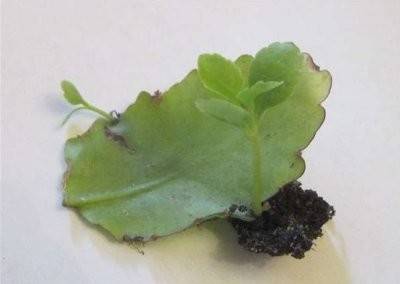

Rooting the tops of the shoots. The crown of the shoot is cut off with a sharp knife, the cut is treated with a solution of the drug "Kornevin" and placed in wet, crushed sphagnum or sand.- Topping. Adult Kalanchoe often stops blooming and becomes nondescript. In this case, you need to remove the shoots on which there were flowers.
After the young shoots begin to grow, pinch 2 leaves on them. Removing the tops helps to stimulate the formation of young growth. - If the shoots are bare at the bottom, but look normal from above, cut off the bare top and root it. You can put the crown in water, or you can immediately plant it in fresh soil and water it abundantly.
The plant will look lethargic at first, but when roots form on it, it will regain its elasticity and begin to develop. Once this happens, cut back on watering.
Choose the optimal place for its existence, follow the care recommendations, do not allow damage by insects, and it will thank you with a long and very decorative flowering.
selo.
Kalanchoe is an indoor flower that serves as a decoration for a room and has medicinal properties. The homeland of this thick-stemmed plant is Madagascar. But despite the fact that the Kalanchoe is from warm edges, it is unpretentious.Considering some of the nuances, the flower will delight the owners for a long time. However, like any other plant, Kalanchoe is subject to disease.
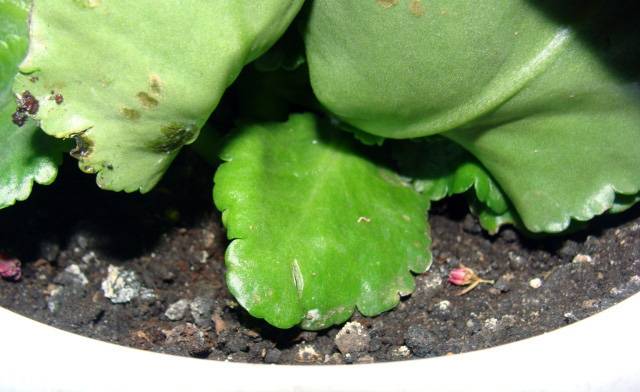

The flower likes daylight hours to last at least 11-13 hours, so the flower should be placed on the windowsills, which are located on the east and west sides. This is true for the spring-autumn period. But in winter, the plant requires more light, so it is recommended to move it to a window facing south, and in the evening, use artificial lighting in addition. If the plant lacks light, the leaves begin to turn yellow and fall off.
If the temperature in the room is below 10 degrees, then the Kalanchoe reacts to this with yellowing of the leaves and death. The temperature comfortable for the growth and development of the plant in the summer will be from 18 to 20 degrees, and in the winter - from 14 to 18.
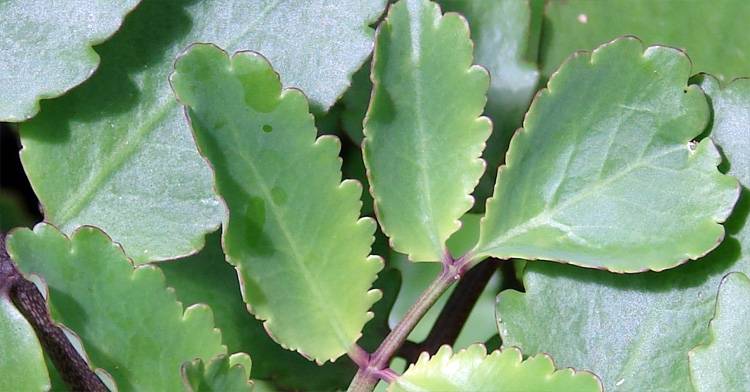

The main reason for the appearance of yellow leaves in Kalanchoe is either unsystematic or excessive watering. The plant should be watered with warm, settled water as the earth dries up, and every two weeks, for the good development of the flower, fertilizers need to be added to the water. If the ground dries out very much, then all the leaves may turn yellow and fall off. To prevent excess moisture, you can water the plant through the tray. One of the reasons for the yellowing of leaves is hard water, so it must be defended, and the most ideal option for watering Kalanchoe is rainwater.
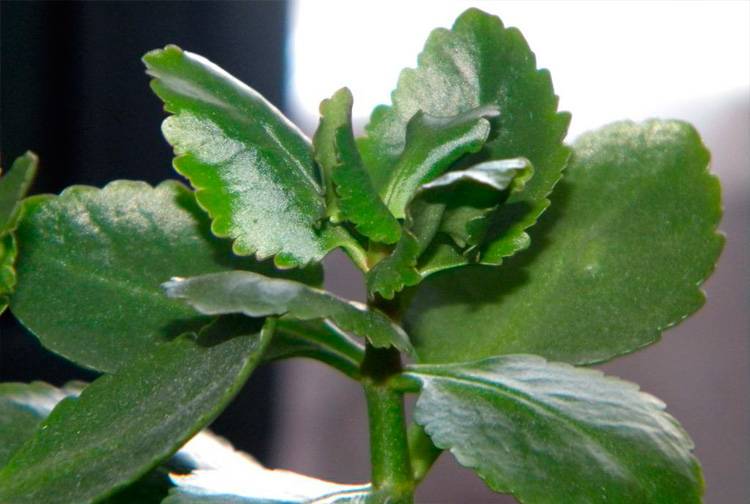

If the air in the room where the Kalanchoe grows is excessively dry, then the leaves turn yellow at the tips. This happens very often in winter, when the heating is on. And if the flower is located next to the battery, then the leaves immediately react with yellowing. To avoid this problem, the flower must be systematically sprayed with water that has been settled for several days. In winter, this procedure is performed often, and in summer, depending on the weather.
Treatment of the plant consists in removing yellowed leaves, determining the cause of this condition and eliminating it.


tbf.su
Problems when growing Kalanchoe
The lush-flowering Kalanchoe houseplant is very popular. The flower is undemanding, has an excellent appearance and is endowed with healing qualities, which are actively used by folk healers in the preparation of medicines.
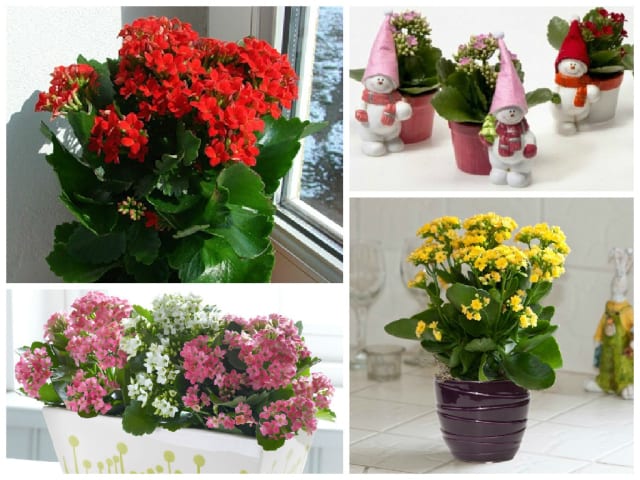

But when growing Kalanchoe, flower growers often face serious problems - falling leaves, darkening of the tips of foliage, the formation of dark spots, etc. All problems, as a rule, are provoked by improper care. Although the Kalanchoe does not require a scrupulous attitude towards itself, nevertheless, improper care can cause illness, and often the death of a plant.
Consider the most common problems that growers face when growing Kalanchoe.
Leaves wither
The first signal to start active actions should be the sluggish state of the flower. The leaf plate of the Kalanchoe softens, begins to brighten, and a little later - falls off.
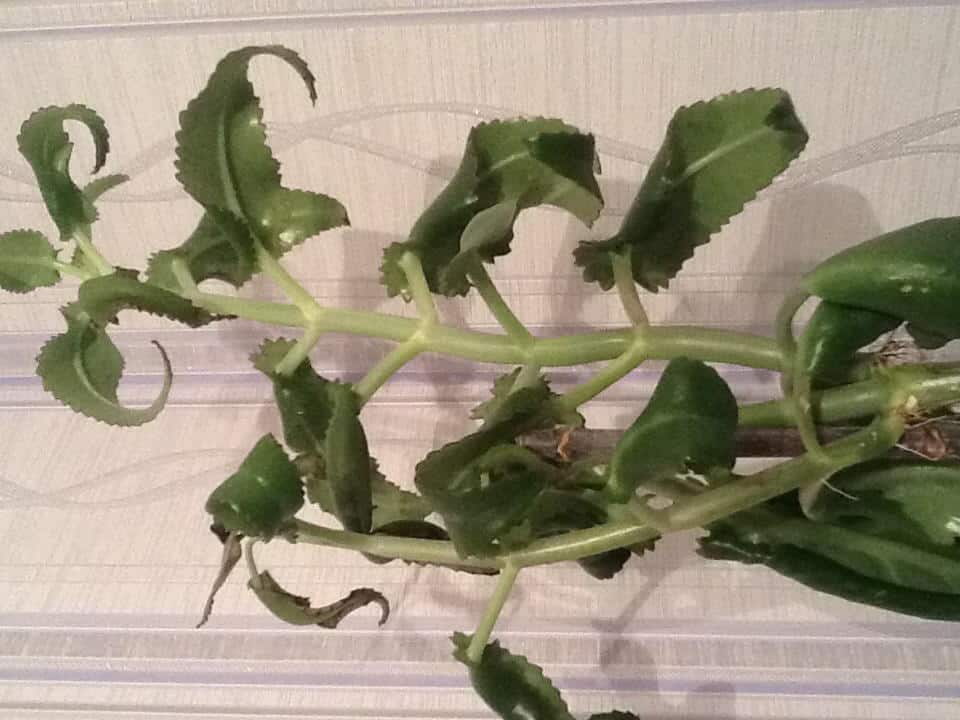

The following points become the reasons for the lethargy of the foliage:
- Excessive watering. Kalanchoe does not require abundant watering, on the contrary, soil moisture should be rare and limited. The leaves of the flower have the ability to accumulate moisture. If the watering of the plant is limited, then its leaves are bright, dense and shiny. Overflowing soil leads to a softening of the leaf plate, disruption of the functionality of the root system and a sluggish appearance of the flower.
- Moisture deficiency. Sparse and poor soil moisture is also undesirable for Kalanchoe. The leaves of the flower are simply not able to accumulate in themselves a sufficient volume of water to last for a long time. If the flower is deficient in moisture, then its leaves wither, dry up and fall off.
- Watering with "wrong" water. Moistening the soil (or spraying the foliage) with cold water often leads to lethargy of the foliage.It is also undesirable to water the plant with ordinary running water. Ideal water for irrigation Kalanchoe - settled for 3 days, room temperature.
- Sunburn. Bright sun rays hitting foliage cause burns. The first signs of foliage injury are yellowing and lethargy.
- A sharp change in climatic conditions. If a flower is moved from a warm room to a cold one (and vice versa), then this will immediately be reflected in its external state. Until the adaptation takes place, the Kalanchoe will look painful and lethargic.
The tips of the leaves dry
The appearance of dryness at the tips of the leaves is a sign of the onset of a painful process. As a rule, the problem is provoked by improper care, namely:
- excessive overflow;
- an excess of sunlight;
- stuffy (or, conversely, cool) temperature regime;
- parasitizing pests.
Leaves turn yellow
Yellowing of leaves on Kalanchoe often happens due to the organization of improper watering or excessive exposure to sunlight. In winter, yellow foliage can appear, on the contrary, with a lack of natural light.
Dry air is dangerous for an indoor flower. If the Kalanchoe is placed next to heating devices, then the air around it must be humidified by artificial methods, for example, by placing glasses of cold water near the pot. The plant also has a negative attitude towards too high air temperature. At the same time, the flower looks quite healthy, but the tips of the foliage begin to turn yellow.
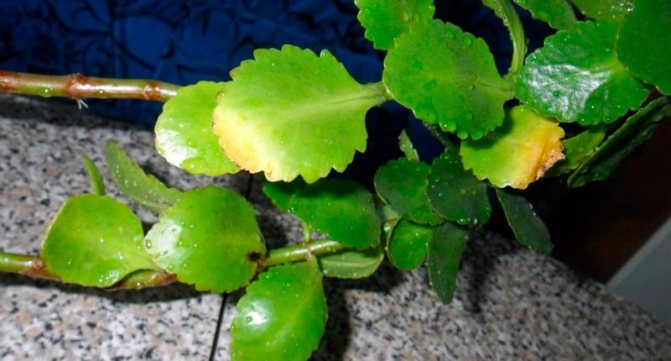

To eliminate the causes of yellow foliage, the plant needs to organize proper care. In winter, it is recommended to "disturb" the flower less. It is good if it stands in a well-lit place, but the duration of daylight hours should not exceed 10 hours. Proper watering is an important condition for the health and active flowering of the Kalanchoe. The plant should not be poured, but it is also not recommended to allow the soil to dry out.
Equipping the soil with top dressing is another condition for proper care. As fertilizers for Kalanchoe, it is required to choose compositions marked “For succulents”. During the growing season, the plant is fed twice a month. In winter, no fertilization is required.
Leaves fall
When the foliage begins to dry sharply on the Kalanchoe and fall off, this is a "signal" of a serious pathological condition. This problem is always provoked by certain reasons, and the most common of them is root decay. Rotting of the root system can occur due to the lack of a drainage layer in the pot, excessive watering of the plant, or parasitic pests.
- lack of sunlight;
- cramped pot;
- parasitizing aphids or scale insects;
- the close location of the flower to heating devices;
- "Advanced" age of the plant.
Lack of flowering
The formation of buds in Kalanchoe occurs only in favorable conditions for it. To observe the bright and active flowering of the Kalanchoe, you need:
- in winter, ensure rest for the plant (put the flower in a room lit by sunlight with a moderately cool temperature of +16 degrees);
- do not overflow the soil (watering should be moderate and not frequent);
- provide the flower with regular feeding during the period of active development.
Why do the leaves wither
Sometimes a succulent flower takes on an unsightly appearance, its leaves begin to wither, they become soft in consistency. If the causes of this phenomenon are not eliminated, the foliage will fall off completely.


The following points lead to such a situation:
- excessive watering. Kalanchoe is able to retain water in its leaves. For this reason, a healthy flower looks dense. The foliage is crumbling - the plant is flooded;
- insufficient watering. This plant can be for some time without additional moisture, but with prolonged drought, the leaf withers and falls off;
- poor water performance.Only soft and settled water can be used for irrigation, otherwise diseases will appear, and the plant will begin to die;
- direct sunlight, which can scorch the leaves;
- improper temperature conditions can also cause the foliage to wither, dry out and fall off.
It is especially important to monitor compliance with these parameters in winter. During the dormant period, the Kalanchoe is especially sensitive, and even small fluctuations in the above parameters can lead to the plant beginning to disappear.


